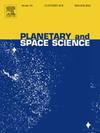Effective feature matching of high-resolution planetary orbiter images based on optimized image partitioning and rapid local correspondence
IF 1.7
4区 物理与天体物理
Q3 ASTRONOMY & ASTROPHYSICS
引用次数: 0
Abstract
Feature matching of high-resolution planetary orbiter images (HRPOIs) plays a significant role in photogrammetric mapping and three-dimensional modeling, which is particularly challenging due to their narrow fields of view, similar surface textures, and large sizes. Neither directly using matching methods nor combining them with traditional strategies can fully overcome the matching challenges posed by HRPOIs. In this study, a feature matching scheme specifically designed for HRPOIs is proposed, which integrates an optimized image partitioning method for overlapping areas and establishes rapid local correspondence between image blocks. A row-to-column grid partitioning method is developed to ensure the range of the partitioned image blocks better align with the boundaries of the complex overlapping areas. Subsequently, the relative positional relationships of the extreme coordinate points in the row direction within the overlapping areas of image pairs are determined to rapidly establish local correspondence between the partitioned images, providing local geometric constraints and avoiding interference caused by redundant features. Moreover, a multilevel efficiency optimization strategy, which combines Graphics Processing Unit (GPU) acceleration with distributed parallelism to enhance the matching efficiency, is designed. Experiments on data derived from the Lunar Reconnaissance Orbiter Narrow Angle Camera (LRO NAC) and Mars Reconnaissance Orbiter Context Camera (MRO CTX) were conducted to validate the feasibility and reliability. The experimental results demonstrate that the proposed scheme effectively overcomes the challenges faced when matching HRPOIs, outperforming several mainstream photogrammetric software in terms of both matching accuracy and efficiency.
基于优化图像分割和快速局部对应的高分辨率行星轨道图像有效特征匹配
高分辨率行星轨道图像(hrpoi)的特征匹配在摄影测量制图和三维建模中发挥着重要作用,但由于其狭窄的视场、相似的表面纹理和较大的尺寸,这一工作尤其具有挑战性。无论是直接使用匹配方法,还是与传统策略相结合,都不能完全克服hrpoi的匹配挑战。本研究提出了一种专门针对hrpoi的特征匹配方案,该方案集成了一种优化的重叠区域图像分割方法,并在图像块之间快速建立局部对应关系。提出了一种行到列的网格分割方法,以保证分割后的图像块范围更好地与复杂重叠区域的边界对齐。随后,确定图像对重叠区域内行方向极值坐标点的相对位置关系,快速建立分割图像之间的局部对应关系,提供局部几何约束,避免冗余特征带来的干扰。在此基础上,设计了一种将GPU加速与分布式并行性相结合的多级效率优化策略,以提高匹配效率。利用月球勘测轨道飞行器窄角相机(LRO NAC)和火星勘测轨道飞行器背景相机(MRO CTX)的数据进行实验,验证了该方法的可行性和可靠性。实验结果表明,该方案有效地克服了hrpoi匹配所面临的挑战,在匹配精度和效率方面均优于几种主流摄影测量软件。
本文章由计算机程序翻译,如有差异,请以英文原文为准。
求助全文
约1分钟内获得全文
求助全文
来源期刊

Planetary and Space Science
地学天文-天文与天体物理
CiteScore
5.40
自引率
4.20%
发文量
126
审稿时长
15 weeks
期刊介绍:
Planetary and Space Science publishes original articles as well as short communications (letters). Ground-based and space-borne instrumentation and laboratory simulation of solar system processes are included. The following fields of planetary and solar system research are covered:
• Celestial mechanics, including dynamical evolution of the solar system, gravitational captures and resonances, relativistic effects, tracking and dynamics
• Cosmochemistry and origin, including all aspects of the formation and initial physical and chemical evolution of the solar system
• Terrestrial planets and satellites, including the physics of the interiors, geology and morphology of the surfaces, tectonics, mineralogy and dating
• Outer planets and satellites, including formation and evolution, remote sensing at all wavelengths and in situ measurements
• Planetary atmospheres, including formation and evolution, circulation and meteorology, boundary layers, remote sensing and laboratory simulation
• Planetary magnetospheres and ionospheres, including origin of magnetic fields, magnetospheric plasma and radiation belts, and their interaction with the sun, the solar wind and satellites
• Small bodies, dust and rings, including asteroids, comets and zodiacal light and their interaction with the solar radiation and the solar wind
• Exobiology, including origin of life, detection of planetary ecosystems and pre-biological phenomena in the solar system and laboratory simulations
• Extrasolar systems, including the detection and/or the detectability of exoplanets and planetary systems, their formation and evolution, the physical and chemical properties of the exoplanets
• History of planetary and space research
 求助内容:
求助内容: 应助结果提醒方式:
应助结果提醒方式:


